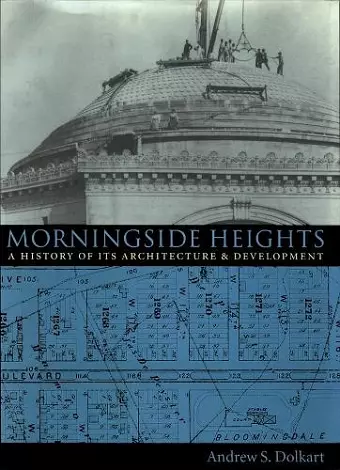Morningside Heights
A History of Its Architecture and Development
Format:Paperback
Publisher:Columbia University Press
Published:19th Apr '01
Currently unavailable, and unfortunately no date known when it will be back

The book tells the stories of the excitement surrounding the initial plans for an Episcopal cathedral and the ultimate failure of this grandiose project; the efforts of John D. Rockefeller, Jr. to build a rival nondenominational church (Riverside Church); the development of Charles McKim's inspired designs for Columbia's campus; the efforts of Barnard and Teachers College to build impressive campuses adjacent to Columbia; and the later projects of Union and Jewish theological seminaries and the Institute of Musical Art (late the Juilliard School) to erect buildings that would be part of the larger institutional concentration, but world provide each with a unique architectural identity.
Morningside Heights, the institutional heart of New York City, is also one of the city's architecturally distinguished neighborhoods. This book explores the architecturally varied complexes built by these organizations. It is suitable for those interested in architecture, urban development, or the history of New York City.Morningside Heights, the institutional heart of New York City, is also one of the city's most architecturally distinguished neighborhoods. The high plateau that forms Morningside Heights is geographically isolated within the city and remained largely undeveloped even as neighboring Harlem and the Upper West Side became prestigious residential communities. At the end of the nineteenth century, institutions relocated to the plateau where sizable plots were available at a convenient distance from the built-up city. In 1887 Episcopal Bishop Henry Potter announced plans for the construction of a great cathedral at the edge of the plateau. The cathedral was soon followed by Columbia College and St. Luke's Hospital, which contemplated grand complexes, and by newer institutions such as Barnard College and Teachers College that were intent on establishing a presence in the rapidly growing city. Thus, Morningside Heights became indelibly associated with New York's educational, medical, and religious foundations, and was appropriately dubbed "the Acropolis of New York." In this extensively illustrated book, Andrew S. Dolkart explores the architecturally varied complexes built by these organizations. He traces the successes and failures of each building project, as trustees and supporters struggled to raise funds in order to construct great campuses in a city where residents were not always generous in their support of such endeavors. Commissioning designs from some of city's and the nation's leading architects, the Morningside Heights institutions created a richly diverse ensemble of buildings. The book tells the stories of the excitement surrounding the initial plans for an Episcopal cathedral and the ultimate failure of this grandiose project; the efforts of John D. Rockefeller, Jr. to build a rival nondenominational church (Riverside Church); the development of Charles McKim's inspired designs for Columbia's campus; the efforts of Barnard and Teachers College to build impressive campuses adjacent to Columbia; and the later projects of Union and Jewish theological seminaries and the Institute of Musical Art (late the Julliard School) to erect buildings that would be part of the larger institutional concentration,...
Combines recondite research with bare-knuckle history, interweaving the nuts and bolts of neighborhood-building with a messy human drama of rivalry, greed, marketing, bigotry and idealism. The New York Times Thorough analysis of this architecturally rich neighborhood. New York Observer Every town, hamlet, and neighborhood deserves an historical portrait by Andrew Dolkart. His history of Morningside Heights is a magnificent work of scholarship that grows out of a true love of urbanism and a profound respect for the contribution of architects and developers, whether high-minded or not-so, to the vitality of place. -- Robert A. M. Stern While Dolkart focuses on aesthetics, his analysis of taste and design is informed by a penetrating knowledge of Manhattan's social history. The resulting book, gracefully written and generously illustrated, will appeal to historians, residents, and anyone whose search for scarce parking on the Heights has taken them past buildings which astonish and delight... Dolkart adeptly explains the social implications behind... artistic decisions... the work is a remarkable social portrait. New York History
ISBN: 9780231078511
Dimensions: unknown
Weight: unknown
544 pages